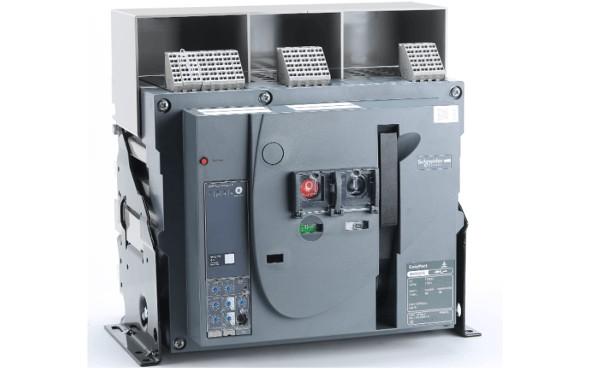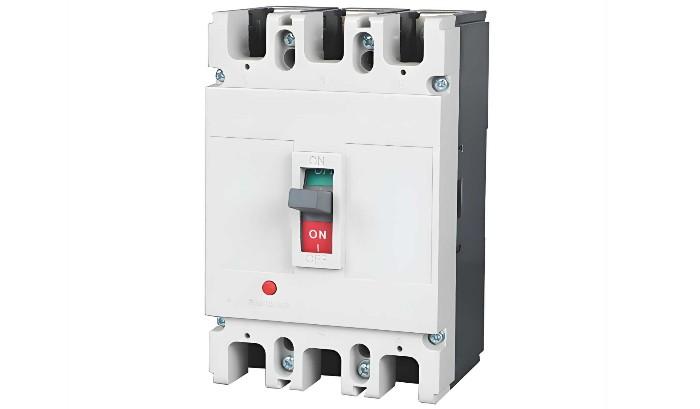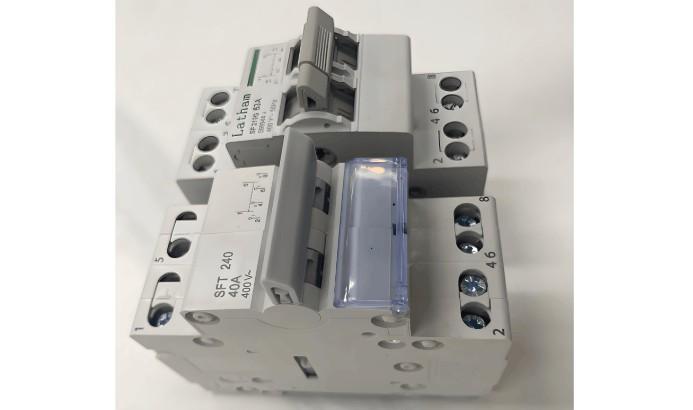Airgeadúcháin Circuit Breakers
(1) Air Circuit Breaker (ACB)
Is é an air circuit breaker, ar a dtugtar freisin molded frame nó universal circuit breaker, ina bhfuil gach comhphóna suite i mframe meála scosaithe. Is gnách go mbíonn sé ag oscailt, rud a cheadaíonn suíomh do chuid rudaí éagsúla, agus is é a úsáideann chun na n-oidhreacht agus na bpáirteanna a athsholáthar go héasca. Tá sé áitithe go coitianta mar an príomhscuiche solais. Iontaofaí overcurrent trip units san electromagnetic, electronic, agus intelligent forms. Soláthraíonn an breaker cáineachas ceathrú: long-time delay, short-time delay, instantaneous, agus ground fault protection. Is féidir gach socruithe cáineachais a athrú sa réimse bunaithe ar mhéid an frame.
Tá air circuit breakers oiriúnach do churleacain AC 50Hz, rated voltages de 380V nó 660V, agus rated currents ó 200A go 6300A i réseáin díolaim. Úsáidtear iad go príomha chun fuinnimh leictreach a roinnt agus chun a chosaint ó overloads, undervoltage, short circuits, single-phase grounding, agus eile de. Soláthraíonn na breakers seo roinnt fiontuithe cosanta intleachtúla agus cuireann siad tuilleadh selectivity. Faoin gcóras gnách, is féidir iad a úsáid don switching infrequent de chuirleacaí. D'fhéadfadh ACBs le ratings suas go 1250A a bheith in úsáid i réseáin AC 50Hz, 380V chun motors a chosaint ó overloads agus short circuits.

Úsáidtear air circuit breakers freisin go minic mar príomhswitches ar an taobh 400V de transformers, bus tie switches, high-capacity feeder switches, agus large motor control switches.
(2) Molded Case Circuit Breaker (MCCB)
Aithnítear an molded case circuit breaker freisin mar plug-in circuit breaker, ina bhfuil terminals, contacts, arc extinguishing chambers, trip units, agus operating mechanisms suite i ngabháil phlastacha. Tá auxiliary contacts, undervoltage trip units, agus shunt trip units go minic modiúla. Tá an struchtúr comhuaine agus ní dhéanann tarbhálachta go hiondúil a chur i gcosaint. Tá sé oiriúnach don chosaint curleacaí sliotáin. Soláthraíonn molded case breakers go minic thermal-magnetic trip units, agus d'fhéadfadh modh móra a bheith leagtha amach le solid-state trip sensors.
Tá overcurrent trip units do MCCBs ar fáil san electromagnetic agus electronic forms. Gnách go mbíonn electromagnetic MCCBs non-selective agus soláthraíonn siad ach long-time delay agus instantaneous protection. Soláthraíonn electronic MCCBs ceithre fheidhm cáineachais: long-time delay, short-time delay, instantaneous, agus ground fault protection. Tá roinnt den electronic MCCBs nua-aimsithe ag soláthar zone-selective interlocking freisin.

Úsáidtear molded case circuit breakers go minic don control agus cosaint curleacaí sliotáin, príomhswitches ar an taobh ísal-voltach de small distribution transformers, terminal power distribution control, agus as power switches do chuid uirlisí tionsclaíocha éagsúla.
(3) Miniature Circuit Breaker (MCB)
Is é an miniature circuit breaker an t-eochair-chórais is coitianta i gcórais díolaim tinte teorainneacha foirgnimh. Úsáidtear é chun cosaint i gcoinne short circuits, overloads, agus overvoltage i gcurleacaí sínle-phhasa agus trí-phhasa suas go 125A, agus tá sé ar fáil i gconfhigúirí single-pole (1P), double-pole (2P), triple-pole (3P), agus four-pole (4P).
Consistíonn MCB de operating mechanism, contacts, protective devices (various trip units), agus arc extinguishing system. Dúnann na príomhcontacts go manual nó go leictreach. Tar éis dúnadh, glactar na contacts i gcomharbhrú faoi chúl ag free-tripping mechanism. Tá an coil den overcurrent trip unit agus an heating element den thermal trip unit ceangailte in series leis an príomhcurleacán, agus tá an coil den undervoltage trip unit ceangailte in parallel leis an soláthar leictreach.

Sa díolaim leictreach forbartha, úsáidtear miniature circuit breakers go príomha chun cosaint agus oibriú a dhéanamh i gcúrsaí mar overload, short circuit, overcurrent, loss of voltage, undervoltage, grounding, leakage, automatic transfer of dual power sources, agus motor starting infrequent.
Príomhcharachtaristic Parameters Circuit Breakers
(1) Rated Operating Voltage (Ue)
Is é an rated operating voltage an nominal voltage den circuit breaker, faoi leith a bhfuil an breaker in ann oibriú leanúnach faoi gcomhdháil normálta seirbhíse agus cáineachais spéisifigh.
In China, do levels voltaga suas go 220kV, is é an maximum operating voltage 1.15 times an system rated voltage; do 330kV agus os a chionn, is é an maximum operating voltage 1.1 times an rated voltage. Caithfidh an circuit breaker insuláid a choimeád agus a bheith in ann closing agus interrupting faoi an maximum operating voltage an chórais.
(2) Rated Current (In)
Is é an rated current an current a d'fhéadfadh an trip unit a thógáil leanúnach ag teocht amhbhiaise lasmuigh de 40°C. Do breakers le trip units adjustable, is é an maximum current a d'fhéadfadh an trip unit a thógáil leanúnach.
Nuair a úsáidtear i teocht amhbhiaise os cionn 40°C ach gan a éirí os cionn 60°C, d'fhéadfadh an breaker oibriú ag load laghdaithe ar feadh tréimhse fada.
(3) Overload Trip Current Setting (Ir)
Nuair a éiríonn an current os cionn an setting Ir an trip unit, triopann an circuit breaker tar éis time delay. Seo chomh maith an maximum current a d'fhéadfadh an breaker a thógáil gan triopan. Caithfear an luach seo a bheith níos mó ná an maximum load current Ib ach níos lú ná an maximum allowable current Iz an chórais.
Do thermal-magnetic trip units, is gnách go mbeadh Ir adjustable laistigh de 0.7–1.0In. Do electronic trip units, is gnách go mbeadh an range níos leata, laistigh de 0.4–1.0In. Do breakers le overcurrent trip units gan aon adhnóireacht, Ir = In.
(4) Short-Circuit Trip Current Setting (Im)
Causing the circuit breaker to trip quickly when high fault currents occur. Is é an trip threshold Im.
(5) Rated Short-Time Withstand Current (Icw)
Is é an current value allowed to pass through the conductor for a specified duration without causing damage due to overheating.
(6) Breaking Capacity
The breaking capacity of a circuit breaker refers to its ability to safely interrupt fault currents, which is not necessarily related to its rated current. Common ratings include 36kA and 50kA. It is generally divided into ultimate short-circuit breaking capacity (Icu) and service short-circuit breaking capacity (Ics).
General Principles for Circuit Breaker Selection
First, select the type and number of poles based on application; then select the rated current based on maximum operating current; finally, choose the type of trip unit and accessories. Specific requirements are as follows:
The circuit breaker’s rated operating voltage ≥ line rated voltage.
The circuit breaker’s rated short-circuit making/breaking capacity ≥ calculated load current of the line.
The circuit breaker’s rated short-circuit making/breaking capacity ≥ maximum possible short-circuit current in the line (usually calculated as RMS value).
Single-phase-to-ground short-circuit current at the end of the line ≥ 1.25 times the instantaneous (or short-time delay) trip setting of the circuit breaker.
The rated voltage of the undervoltage trip unit = line rated voltage.
The rated voltage of the shunt trip unit = control power supply voltage.
The rated operating voltage of the electric operating mechanism = control power supply voltage.
When used in lighting circuits, the instantaneous trip setting of the electromagnetic trip unit is generally 6 times the load current.
When using a circuit breaker for short-circuit protection of a single motor, the instantaneous trip setting is 1.35 times the motor starting current (for DW series) or 1.7 times (for DZ series).
When using a circuit breaker for short-circuit protection of multiple motors, the instantaneous trip setting is 1.3 times the starting current of the largest motor plus the operating currents of the remaining motors.
When using a circuit breaker as the main switch on the low-voltage side of a distribution transformer, its breaking capacity should exceed the short-circuit current on the low-voltage side of the transformer. The trip unit’s rated current should not be less than the transformer’s rated current. The short-circuit protection setting is generally 6–10 times the transformer’s rated current; the overload protection setting equals the transformer’s rated current.
After preliminarily selecting the circuit breaker type and rating, coordination with upstream and downstream protective devices is required to avoid cascading tripping and minimize accident scope.
Selectivity of Circuit Breakers
In distribution systems, circuit breakers are classified as selective or non-selective based on protection performance. Selective low-voltage circuit breakers have either two-stage or three-stage protection. Instantaneous and short-time delay characteristics are used for short-circuit protection, while long-time delay characteristics are used for overload protection. Non-selective breakers are typically instantaneous, used only for short-circuit protection, or long-time delay, used only for overload protection.
In distribution systems, if the upstream breaker is selective and the downstream breaker is non-selective or selective, selectivity is achieved by utilizing the time delay of the short-time delay trip unit or differences in time delay settings. When the upstream breaker operates with time delay, consider the following:
Regardless of whether the downstream breaker is selective or non-selective, the instantaneous overcurrent trip setting of the upstream breaker should generally be no less than 1.1 times the maximum three-phase short-circuit current at the downstream breaker’s output.
If the downstream breaker is non-selective, to prevent the upstream short-time delay overcurrent trip unit from operating first due to insufficient sensitivity of the downstream instantaneous trip unit during a short circuit, the short-time delay overcurrent trip setting of the upstream breaker should generally be no less than 1.2 times that of the downstream breaker’s instantaneous trip unit.
If the downstream breaker is also selective, to ensure selectivity, the short-time delay operating time of the upstream breaker should be at least 0.1 seconds longer than that of the downstream breaker.
Generally, to ensure selective operation between upstream and downstream low-voltage circuit breakers, the upstream breaker should preferably have a short-time delay overcurrent trip unit, and its operating current should be at least one level higher than that of the downstream trip unit. At minimum, the upstream operating current Iop.1 should be no less than 1.2 times the downstream operating current Iop.2, i.e., Iop.1 ≥ 1.2Iop.2.
Cascading Protection of Circuit Breakers
In distribution system design, coordination between upstream and downstream circuit breakers must achieve "selectivity, speed, and sensitivity." Selectivity relates to coordination between breakers, while speed and sensitivity are associated with the characteristics of the protective device and the operating mode of the circuit.
Proper coordination between upstream and downstream breakers enables selective isolation of the faulty circuit, ensuring other non-faulty circuits continue normal operation. Poor coordination affects system reliability.
Cascading protection is a practical application of the current-limiting characteristics of circuit breakers. Its main principle is to utilize the current-limiting effect of the upstream breaker (QF1), which allows selection of a downstream breaker (QF2) with lower breaking capacity, thus reducing cost. The current-limiting upstream breaker QF1 can interrupt the maximum prospective short-circuit current at its installation point. Since the upstream and downstream breakers are connected in series, when a short circuit occurs at the output of the downstream breaker QF2, the actual short-circuit current is significantly reduced by the current-limiting effect of QF1, far below the prospective short-circuit current at that point. Thus, the breaking capacity of QF2 is effectively enhanced by QF1, exceeding its rated breaking capacity.
Cascading protection has certain conditions: for example, adjacent circuits should not have critical loads (since tripping of QF1 would also de-energize QF3’s circuit), and the instantaneous settings of QF1 and QF2 must be properly matched. Cascading data can only be determined experimentally, and coordination between upstream and downstream breakers must be provided by the manufacturer.
Sensitivity of Circuit Breakers
To ensure reliable operation of the instantaneous or short-time delay overcurrent trip unit under minimum system operating conditions and during the mildest short-circuit fault within its protection range, the sensitivity of the circuit breaker must meet the requirements of the "Low-Voltage Electrical Distribution Design Code" (GB50054-95), which specifies a sensitivity of no less than 1.3, i.e., Sp = Ik.min / Iop ≥ 1.3. Here, Iop is the operating current of the instantaneous or short-time delay overcurrent trip unit, Ik.min is the single-phase or two-phase short-circuit current at the end of the protected line under minimum system operating conditions, and Sp is the sensitivity of the circuit breaker.
When selecting a circuit breaker, its sensitivity should also be verified. For selective breakers with both short-time delay and instantaneous overcurrent trip units, only the sensitivity of the short-time delay trip unit needs to be checked; the sensitivity of the instantaneous trip unit does not require verification.
Selection and Setting of Circuit Breaker Trip Units
(1) Setting of Instantaneous Overcurrent Trip Unit Operating Current
Some electrical equipment protected by the circuit breaker has high peak currents during startup, several times the rated current, causing the breaker to experience high peak currents briefly. The operating current Iop(o) of the instantaneous overcurrent trip unit must exceed the circuit’s peak current Ipk, i.e., Iop(o) ≥ Krel·Ipk, where Krel is the reliability factor. When selecting a circuit breaker, ensure its instantaneous overcurrent trip setting exceeds the peak current to prevent nuisance tripping.
(2) Setting of Short-Time Delay Overcurrent Trip Unit Operating Current and Time
The operating current Iop(s) of the short-time delay overcurrent trip unit should also exceed the circuit’s peak current Ipk, i.e., Iop(s) ≥ Krel·Ipk, where Krel is the reliability factor. Short-time delay trip times are generally 0.2s, 0.4s, or 0.6s, determined based on selectivity with upstream and downstream protection devices, ensuring the upstream device operates later than the downstream by one time step.
(3) Setting of Long-Time Delay Overcurrent Trip Unit Operating Current and Time
The long-time delay overcurrent trip unit is primarily used for overload protection. Its operating current Iop(l) only needs to exceed the circuit’s maximum load current (calculated current I30), i.e., Iop(l) ≥ Krel·I30, where Krel is the reliability factor. The operating time should exceed the duration of allowable short-term overloads to prevent nuisance tripping.
(4) Coordination Requirements Between Overcurrent Trip Unit Operating Current and Protected Circuit
To prevent insulation damage or fire due to overloads or short circuits without the circuit breaker tripping, the overcurrent trip unit’s operating current Iop must satisfy the condition: Iop ≤ Kol·Ial. Here, Ial is the allowable current-carrying capacity of the insulated cable; Kol is the allowable short-term overload factor—typically 4.5 for instantaneous and short-time delay trip units, 1.1 for long-time delay trip units used for short-circuit protection, and 1.0 when used only for overload protection. If this coordination requirement is not met, the trip unit setting should be adjusted, or the conductor or cable cross-section should be increased appropriately.
























